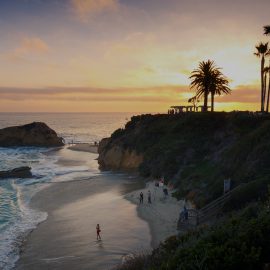Long Beach Opioid Epidemic and Addiction Statistics

The nationwide opioid epidemic is prevalent in Long Beach and surrounding areas in Southern California. Opioid addiction is not the only substance abuse issue in Long Beach, and the addiction statistics mean that many in this area might not be getting the treatment they need. Due to the stress of the worldwide COVID-19 pandemic, rates of addiction have been on the rise.
The Opioid Epidemic in Long Beach
The Drug Enforcement Agency (DEA) has initiated “Operation Engage” to combat the top local drug threat of communities throughout the US. The Los Angeles Field Divison of the DEA has “identified fentanyl, a powerful synthetic opioid, as the area’s top drug threat.” Fentanyl is responsible for nearly half of the 3,200 overdose deaths in California during 2019.
Opioid addiction can start with a prescription medication that leads to dependence or misuse. The Centers for Disease Control and Prevention (CDC) warns that “serious risks are associated with [prescription opioid] use, and it is essential to carefully consider the risks of using prescription opioids alongside their benefits. These risks include misuse, opioid use disorder (addiction), overdoses, and death.”
The California Overdose Surveillance Dashboard list the following opioid statistics in Los Angeles County for 2020:
- 1,298 overdose deaths related to any opioid
- 2,388 emergency department visits related to opioid overdose
- 655 opioid overdose-related hospitalizations
- 2,992,298 total opioid prescriptions in Los Angeles County
While opioids present the most dangerous in terms of overdose deaths, residents of Long Beach and Southern California also struggle with other addictions. While not all addictions have deadly consequences, they can severely impact your ability to live a high quality of life and can significantly affect your overall health and wellbeing.
Addiction Statistics in Long Beach and LA County
Alcohol remains one of the most used substances in the United States. The National Institute of Alcohol Abuse and Alcoholism (NIAAA) shares that “[a]ccording to the 2019 National Survey on Drug Use and Health (NSDUH), 85.6 percent of people ages 18 and older reported that they drank alcohol at some point in their lifetime.”
Problem Drinking in LA County
- In 2019, alcohol use disorder was most prevalent in adults aged 18-25 (10.5%); a total of 6.1% of people 12 and older had an alcohol use disorder.
- Publicly funded substance use treatment centers saw that 20.0% of their patients had alcohol as their primary substance use disorder (methamphetamine accounted for 30.4%, followed by heroin at 30.1%).
- A total of 130,587 motor vehicle collisions involving alcohol resulted in 74,810 injuries and 2,363 fatalities from 2007 to 2017.
Marijuana Statistics in LA County
Data from the Los Angeles County Department of Public Health regarding marijuana use shows that:
- “From 2014 to 2016, 32.2% of Los Angeles County (LAC) young adults (aged 18-25 years) had used marijuana in the past year.”
- “From 2005 to 2017, [hospitalizations due to marijuna] increased by 388%.”
- “[Emergency department] visits due to marijuana (records that listed marijuana poisoning, dependence, or abuse as the primary diagnosis) increased 1,092% from 2005 to 2017.”
Methamphetamine Use in LA County
Methamphetamine statistics in LA County show an increase in use, according to the most current data available:
- “[M]eth poisoning as a cause of death and drug overdose as the underlying cause of death (meth-related) increased 707% from 43 in 2008 to 347 in 2017.”
- “The percent of all underlying drug overdose deaths that listed meth poisoning as a cause of death increased from 6% in 2008 to 38% in 2017.”
- “[N]umber of fatal traffic crashes in LAC involving a person testing positive for meth increased 222% from 32 in 2008 to 103 in 2016.”
Long Beach Addiction Statistics
In February 2020, the City of Long Beach published a memorandum “on drug use, addiction, overdose, and death statistics in Long Beach over the past five years.” Some of the statistics include:
- A total of 187 overdoses occurred from July through November 2019; 40% were due to opioids, and 32% were from amphetamines.
- From 2014-2018, 286 substance-related deaths occurred within the city of Long Beach.
- During June 2018-November 2019, Narcan was administered during 335 of a total of 406 overdose incidents.
The City of Long Beach Department of Public Health and Human Services released a community health assessment in 2019, which shows some of the following addiction and substance abuse statistics:
- “The rates of hospitalizations due to both alcohol misuse and substance use are greater in Long Beach than the rates for Los Angeles County and the state of California.”
- “Hospitalizations due to alcohol misuse are increasing over time (from 13.4 hospitalizations per 10,000 population 18 and older in 2010-2012).”
- “The percentage of adults who smoke [including tobacco and marijuana] in Long Beach (15.1%) is higher than both the Los Angeles County value and California value (both 11.7%).”
Opioid and Other Addiction Treatment in Long Beach
The addiction statistics and increasing opioid epidemic in the US have also impacted the residents of Long Beach and Los Angeles County. You or a loved one might be struggling with opioid misuse or other addictions, like alcohol or methamphetamine. Gratitude Lodge of Southern California is here to help you or your loved one overcome addiction and live the life you deserve. Call us or visit our admissions page to start your recovery journey today.
Call us now
Help for you or a loved one
is only one call away.
Resources
Don’t Let Addiction Control You
LET US HELP YOU FIND
YOUR NEW BEGINNING
Recent Articles
Similar Reads
Notice: Undefined variable: recent in /home/gratitudelodge/public_html/wp-content/themes/gratitude-lodge/single.php on line 107
Notice: Trying to access array offset on value of type null in /home/gratitudelodge/public_html/wp-content/themes/gratitude-lodge/single.php on line 107
Notice: Undefined variable: recent in /home/gratitudelodge/public_html/wp-content/themes/gratitude-lodge/single.php on line 107
Notice: Trying to access array offset on value of type null in /home/gratitudelodge/public_html/wp-content/themes/gratitude-lodge/single.php on line 107
Notice: Undefined variable: recent in /home/gratitudelodge/public_html/wp-content/themes/gratitude-lodge/single.php on line 107
Notice: Trying to access array offset on value of type null in /home/gratitudelodge/public_html/wp-content/themes/gratitude-lodge/single.php on line 107
Notice: Undefined variable: recent in /home/gratitudelodge/public_html/wp-content/themes/gratitude-lodge/single.php on line 107
Notice: Trying to access array offset on value of type null in /home/gratitudelodge/public_html/wp-content/themes/gratitude-lodge/single.php on line 107
Notice: Undefined variable: recent in /home/gratitudelodge/public_html/wp-content/themes/gratitude-lodge/single.php on line 107
Notice: Trying to access array offset on value of type null in /home/gratitudelodge/public_html/wp-content/themes/gratitude-lodge/single.php on line 107
Our Partners
We accept most PPO insurance
Drug and alcohol rehab should be accessible to everyone. At Gratitude Lodge,
we work with most insurance plans to cover the costs of treatment.





















